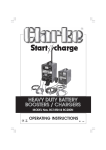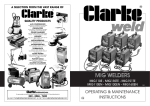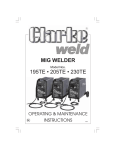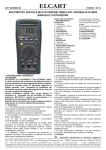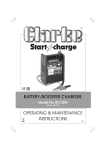Download Clarke BC170 Operating instructions
Transcript
HEAVY DUTY BATTERY BOOSTERS / CHARGERS MODEL Nos. BC150, BC170, BC180B & BC200B OPERATING INSTRUCTIONS 1202 NOTES For Spare Parts and Service, please contact your nearest dealer, or CLARKE International, on one of the following numbers. PARTS & SERVICE TEL: 020 8988 7400 PARTS & SERVICE FAX: 020 8558 3622 or e-mail as follows: PARTS: [email protected] SERVICE: [email protected] 1 18 Thank you for purchasing this CLARKE Battery Charger. These units are suitable for charging and boosting 12 Volt lead acid batteries. Models BC180B and BC200B are also capable of charging 24Volt batteries. Before attempting to operate the unit, please read this instruction manual thoroughly, and follow all directions carefully. By doing so you will ensure the safety of yourself, and others around you, and at the same time, you should look forward to the unit giving long and trouble free service. GUARANTEE This product is guaranteed against faults in manufacture for 12 months from date of purchase. Please keep your receipt as proof of purchase. This guarantee is invalid if the product has been found to have been abused in any way, or not used for the purpose for which it was intended, or to have been tampered with in any way. The reason for return must be clearly stated. This guarantee does not affect your statutory rights. CONTENTS PAGE Parts and Service Contacts ............................................................ 1 Safety Precautions .......................................................................... 3 Assembly Instructions ...................................................................... 4 Electrical Connections 12 Volt Charging .................................. 5 24 Volt Charging .................................. 5 Parts Identification ........................................................................... 6 Procedure For Normal Charging ................................................... 7 Procedure For Engine Starting ....................................................... 9 Specifications .................................................................................. 10 Replacement Fuses ......................................................................... 10 Parts & Service Contacts ................................................................ 10 Parts Lists & Diagrams ...................................................................... 11 Wiring Diagrams ............................................................................... 15 17 2 IMPORTANT: SAFETY PRECAUTIONS PLEASE READ BEFORE USING THIS UNIT 1. WARNING: Some electronic equipment can be damaged by boost WIRING DIAGRAMS BC180B charging or use of start facility. Check your vehicle handbook before using your Start ’N’ Charge. If in doubt consult the vehicle manufacturer. Nevertheless, you should not operate this equipment unless you are fully conversant with vehicle electrical systems, and battery charging techniques. 2. WARNING: Because highly inflammable hydrogen gas is released in the process of battery charging, please remember to switch OFF the charger first, and so avoid sparking which will occur when CONNECTING OR DISCONNECTING LIVE LEADS. 3. Black negative (-ve) lead must always be clipped to the negative, and Red positive (+ve) lead must always be clipped to the positive. When charging with battery installed in vehicle, or boosting, FIRST connect the appropriate lead to the UNEARTHED battery terminal (on most modern cars this is the positive (+ve) terminal), then connect the other lead to the chassis (or a suitable engine bolt) away from the battery and fuel line. It is advisable to disconnect the unearthed terminal from the battery, when charging in situ. When disconnecting, remove the chassis lead FIRST, then the battery lead. 4. To prevent battery overheating and consequent damage, use the BOOST facility sparingly and do not exceed our recommendations. 5. Battery acid is highly corrosive. If spillage occurs, wipe off immediately and wash copiously with water. Particularly avoid contact with the eyes, but if this occurs, you must seek medical advice. 6. When charging is completed, ensure that the vehicle battery leads are secured to the proper terminals which should be clean and lightly smeared with petroleum jelly to prevent corrosion. Finally, re-check the electrolyte level. 7. Do not expose this unit to rain. 8. Never touch together the negative and positive leads on this unit whilst the unit is switched on. 9. Never attempt any electrical or mechanical repair. If you have a problem with your machine contact your local stockist for service information. 10. WARNING: Certain types of sealed or maintenance-free batteries need extra care when charging. Please consult battery manufacturers instructions before using this unit. 11. WARNING: Since toxic fumes may be released during battery charging, ONLY USE THIS UNIT IN A WELL VENTILATED AREA. BC200B 12. Before charging ensure the battery terminals are clean and that the cells are filled with electrolyte to the correct level by adding distilled water where necessary. 3 16 WIRING DIAGRAMS ASSEMBLY INSTRUCTIONS. BC150 BCI80B and BC200B 1) Insert the plastic handle into the top of the unit and secure with the screws provided. 2) Insert the tubular metal handle into the plastic handle and secure with two screws provided. 3) Using the four small bolts supplied secure the metal supporting foot to the base of the charger and at same time locate the axle in the slot provided. 4) Push one wheel onto each end of the axle and retain in position by tapping one of the retaining washers supplied, about 5 mm. on to the axle shaft at each end using a piece of tube or old socket etc., noting that the tines of the washer face outwards. BC170 15 4 . ELECTRICAL CONNECTIONS PARTS LIST AND DIAGRAM WARNING! THIS APPLIANCE MUST BE EARTHED. BC200B A. 12 volt CHARGING - All Models Connect the mains lead to a 230 volt (50Hz) domestic electrical supply via a standard 13 amp BS 1363 plug fitted with a 13 amp fuse, or a suitably fused isolator switch. IMPORTANT: The wires in the mains lead are coloured in accordance with the following code: Green & Yellow Blue Brown - Earth Neutral Live As the colours of the flexible cord of this appliance may not correspond with the coloured markings identifying terminals in your plug, proceed as follows: • • Connect GREEN & YELLOW coloured cord to plug terminal marked with a letter ‘E’ or Earth symbol “ ”, or coloured GREEN or GREEN & YELLOW. Connect BROWN coloured cord to plug terminal marked ‘L’ or coloured RED. • Connect BLUE coloured cord to plug terminal marked ‘N’ or coloured BLACK. We strongly recommend that this unit is connected to the mains supply via a Residual Current Device (RCD). IMPORTANT! If this appliance is fitted with a plug which is moulded onto the electric cable (i.e. non-rewireable) please note: 1. The plug must be thrown away if it is cut from the electric cable. There is a danger of electric shock if it is subsequently inserted into a socket outlet. 2. Never use the plug without the fuse cover fitted. 3. Should you wish to replace a detachable fuse carrier, ensure that the correct replacement is used (as indicated by marking or colour code). 4. Replacement fuse covers can be obtained from your local dealer or most electrical stockists. Fuse Rating The fuse in the plug must be replaced with one of the same rating (13 amps) and this replacement must be ASTA approved to BS1362. Extension Cable If an extension cable is fitted, ensure the minimum cross section of the conductor is 1.5mm2 for up to 15 metres in length, and 2.5mm2 for up to 25 metres. B. 24 Volt Charging (BC180B and BC200B) If these units are used for 24 volt boosting or charging, they MUST be connected to a 230V 50Hz, single phase supply, through a suitably fused isolator, with a fuse rating of 15 Amps. DO NOT connect via a 13 Amp Plug. 5 No. Description Part No. No. Description Part No. 1 Upper Panel EM33705007 15 Red Cable EM43200026 2 Handle EM21600004 16 Clamp EM22110005 3 Back Panel EM33715037 17 Din. Plug EM22100001 4 Rectifier EM22400006 18 Foot EM33740015 5 Thermostat EM04600113 19 Din. Socket EM22100002 6 Lower Panel EM33700023 20 Wheels-axle EM55200012 7 Switch EM22205007 21 Wheel EM21625006 8 Switch Knob EM21690015 22 Transformer EM44105006 9 Ammeter EM22600015 23 Fuse Holder Box EM21690113 10 Input Cable EM22610006 24 Fuse I00A EM22220030 11 Orange Pilot-lamp EM22610012 25 Small Fuse Box Cover EM21690109 12 Cable Clamp EM21605010 26 Handle EM33725029 13 Input Cable EM20220014 27 Handle-extension Knob EM21600006 14 Black Cable EM43200014 14 PARTS LIST AND DIAGRAM PARTS IDENTIFICATION BC180B BC150 & 170 FIG. 1 1 - Ammeter 2 - Charge/Boost Start Switch 3 - MIN/MAX Charge Rate Sw. 4 - ON/OFF Switch 5 - Mains Lead 6 - RED, Positive Lead 7 - Black Negative Lead BC180B & BC200B No. Description Part No. No. Description Part No. FIG. 2 1 Upper Panel EM33705007 15 Red Cable EM43200010 2 Handle EM21600004 16 Clamp EM22110005 3 Back Panel EM33715037 17 Din. Plug EM22100001 1 - Amperage Control Knob 4 Rectifier EM22400020 18 Foot EM33740015 2 - Ammeter 5 Thermostat EM04600113 19 Din. Socket EM22100002 3 - Mains indicator Lamp 6 Lower Panel EM33700021 20 Wheels-axle EM55200012 4 - Thermal Overload indicator 7 Switch EM22205008 21 Wheel EM21625014 8 Switch Knob EM21690015 22 Transformer Starter EM44105022 9 Ammeter EM22600014 23 Fuse Holder Box EM21690113 10 Green Pilot-lamp EM22610006 24 Fuse 120A EM22220029 7 - 12 V Positive Terminal 11 Orange Pilot-lamp EM22610012 25 Small Fuse Box Cover EM21690109 8 - RED, Positive Lead 12 Cable Clamp EM21605010 26 Handle EM33725029 9 - Black, Negative Lead 13 Input Cable EM20220014 27 Rubber Grip EM21600006 14 Black Cable EM43200012 13 5 - Mains Lead 6 - 24V Positive Terminal 6 PROCEDURE FOR NORMAL CHARGING PARTS LIST AND DIAGRAM BCI50 & BC170 BC170 (Ref: Fig. 1). 1) Before charging or boosting, ensure that the cells are filled with electrolyte to the correct level by adding distilled water where necessary. 2) Where appropriate we recommend that the non-earthed lead on the battery is disconnected prior to charging. It is possible that damage may occur to any electronically controlled system fitted to the vehicle such as engine management, anti-theft alarm, alternator etc. 3) Check that the ON/OFF switch (4) on the unit is in the OFF position. 4) Connect the appropriate lead to the unearthed battery terminal (on most modern cars this is positive (+ve) terminal), then connect the other lead to the chassis (or a suitable engine bolt) away from the battery and fuel line. 5) Remove the battery filler caps during charging in order to prevent the build up of dangerous gases within the battery. 6) Switch the CHARGE/BOOST START switch (2) to the CHARGE position. 7) Set the MIN/MAX (minimum charge/maximum charge) switch (3) to the MIN position. This is suitable for charging most normal car batteries (having a rating of approximately 40 A.H.). 8) Switch the ON/OFF switch (4) to ON, and charging will commence. 9) Keep the battery on charge until the Ammeter gauge (1) reads zero (or 0-2 amps) or has stopped moving down. Then switch OFF at the machine. 10) When disconnecting the charger, disconnect 1. supply, 2. chassis conductor and 3. battery conductor, IN THAT ORDER. Important: If the fixed positive lead and the fixed negative lead are connected to the wrong terminals, then a flash will occur when the 2nd. Clamp is attached. Damage to the charging unit and the battery will be avoided as your start n charge is fitted with a polarity protection feature. It will however be necessary to replace the internal fuse. Remove the black plastic cover on the back panel (marked ‘fuse’) and replace the burnt fuse with an exact replacement. See page 10 for replacement fuses. Notes on charging procedure. * A complete charge is best done slowly in order to protect your battery, so we recommend the MIN setting as described above. A complete charge may take up to 10 hours. ** If a low amperage reading (2 amps or less) is seen on the gauge at either the MIN or MAX setting, this may indicate that the battery is either (a) already fully charged or (b) at the end of its useful life and in need of replacement. Do not charge the battery for longer than is necessary. WARNING: Do not attempt to re-charge non-rechargeable batteries. 7 No. 1 2 3 4 5 6 7 8 9 10 11 12 13 14 15 16 17 18 19 Description Qty Hamdle Upper Pamel Fromt Pamel Om/Off Switch Weldimg Curremt Switch Ammeter Imput Cable W/Plug+13a Fuse Cable Clamp Red Cable Earth Clamp Black Cable Lower Pamel Tramsformer Tramsformer Thermostat Rectifier Complete Thermostat + Support Fuse Holder Box Fuse 120a Small Fuse Cover 12 1 1 1 1 2 1 1 3 1 2 1 1 1 1 1 1 1 1 1 Part No. EM21600001 EM33705108 EM33710281 EM22200002 EM22200006 EM22600014 EM20220068 EM21605009 EM43200011 EM22110005 EM43200012 EM33700089 EM44105058 EM22210603 EM22400088 EM04600113 EM21690113 EM22220029 EM21690109 7. BCI8OB and BC200B PARTS LIST AND DIAGRAM BC150 (Ref: Fig. 2). 1) Before charging or boosting ensure that the cells are filled with electrolyte to the correct level by adding distilled water where necessary. 2) Where appropriate we recommend that the non-earthed lead on the battery is disconnected prior to charging. It is possible that damage may occur to any electronically controlled system fitted to the vehicle such as engine management anti-theft alarm, alternator etc. 3) Check the mains supply is OFF and the amperage control knob (1) is in the OFF position. 4) Connect the red positive lead (8) to either the (+ve) 24V terminal (6), or the (+ve) 12V terminal (7) as appropriate, by inserting the jack plug and twisting clockwise to a locked position. 5) Connect the appropriate lead to the unearthed battery terminal (on most modern cars this is the positive (+ve) terminal), then connect the other lead to the chassis (or a suitable engine bolt) away from the battery and fuel line. 6) Remove the battery filler caps during charging to prevent the build-up of dangerous gases within the battery. 7) Switch on the mains supply. 8) Turn the amperage control knob (1) clockwise to the position necessary to obtain the desired charging rate as indicated on the ammeter (2) (see notes below). 9) Keep the battery on charge until the ammeter (2) reads zero (or 0-2 amps), or has stopped moving down. Then switch the amperage control knob (1) back to the OFF position. NOTE: The BC180B is fitted with a 3 position amperage control knob...the BC200B with a 6 position knob, giving a wider range of control. No. 1 2 3 4 5 6 7 8 9 10 11 12 13 14 15 16 17 18 Description Part No. Handle Upper Panel Front Panel On/Off Switch Welding Current Switch Ammeter Input Cable W/Plug -13a Fuse Cable Clamp Red Cable Earth Clamp 120a Black Cable Lower Panel Transformer Thermostat Rectifier Fuse Holder Box Fuse 75a Small Fuse Cover 1 1 1 1 2 1 1 3 1 2 1 1 1 1 1 1 1 1 11 EM21600001 EM33705108 EM33710281 EM22200002 EM22200006 EM22600014 EM20220068 EM21605009 EM43200011 EM22110005 EM43200012 EM33700089 EM44105067 EM22210014 EM22400042 EM21690113 EM22220031 EM21690109 10) When disconnecting the charger, disconnect 1. supply, 2. chassis conductor and 3. battery conductor, IN THAT ORDER. Important: If the fixed positive lead and the fixed negative lead are connected to the wrong terminals, then a flash will occur when the 2nd. Clamp is attached. Damage to the charging unit and the battery will be avoided as your start n charge is fitted with a polarity protection feature. It will however be necessary to replace the internal fuse. Remove the black plastic cover on the back panel (marked ‘fuse’) and replace the burnt fuse with an exact replacement. See page 10 for replacement fuses. Notes on charging procedure. * A complete charge is best done slowly in order to protect your battery. We recommend that the charging rate (amps) should not exceed 10% of the battery capacity rating (Amps hours) i.e., an average normal car battery has an Amp hour rating of approximately 40 A.H. so the charging rate should not exceed 4 amps (a complete charge should therefore take approximately 10 hours). Select the position on the amperage control knob (1) which indicates as near as possible this charging rate on the Ammeter gauge (2). ** If a low amperage reading (2 amps or less) is seen on the Ammeter gauge (2) at any of the settings on the amperage control knob (1), it may indicate that the battery is either (a) already fully charged or (b) at the end of its useful life and in need of replacement. WARNING: Do not attempt to recharge non-rechargeable batteries. 8 PROCEDURE FOR ENGINE STARTING BC150 & BC170 (Re: Fig.1) Note: We recommend that before attempting to boost start you charge the battery for 10-15 minutes. This will improve the chance of a first time start, particularly with big engines. When the battery is completely flat, you must charge the battery for 10-15 minutes before attempting to start, otherwise you may cause damage to the vehicle electronic systems. a) Check that the ON/OFF switch (4) is in the OFF position. b) Connect the cables as for normal charging. c) Check that the CHARGE/BOOST START switch (2) is in the BOOST position. d) e) Switch the ON/OFF, switch to the ON position. Turn the key in the vehicles ignition to ‘start’, and get an assistant to switch the CHARGE/ BOOST START switch (2) to CHARGE position IMMEDIATELY the engine starts, or after a maximum of 5 seconds (BC150) or 10 seconds (BC170), if the engine fails to start. Failure to do this may cause damage to some electronic equipment. SPECIFICATIONS MODEL 150 170 180B 200B MAX CHARGE (AMPS) 15 20 20 30 MAX BOOST (AMPS) 140 160 180 200 BOOST/CHARGE (VOLTS) 12 12 12/24 12/24 BOOST START DUTY CYCLE Max 5 secs ON Max 10 secs ONMax 10 secs ON Max 10 secs ON THERMAL OVERLOAD PROTECTION DIMENSIONS (LxWxH) mm. WEIGHT kg. IMPORTANT: You must return the CHARGE/BOOST START switch to CHARGE position after a maximum of 5 seconds - 150 or 10 seconds - 170, on boost start. Wait 20 seconds - 150 or 60 seconds - 170, before repeating. Failure to do this may damage the battery and the Start ‘N’ Charge unit and may invalidate your guarantee. BCI8O and BC200B PART NO. 20 secs OFF 60 secs OFF 30 secs OFF 30 secs OFF YES YES YES YES 260X260X250 260X260X210 260X300X770 260X300X770 10 12.5 16 21 6210185 6210190 6210180 6220000 This battery charger is designed to charge either 12V or 24V lead-acid automotive batteries. Do not attempt to recharge any other type of battery. Do not use the battery charger as a power source. (Re: Fig.2) Note: We recommend that before attempting to boost start, you charge the battery for 10 to 15 minutes. This will improve the chance of a first time start, particularly with bigger engines. When the battery is completely flat, you must charge the battery for 10-15 minutes before attempting to start, otherwise you may cause damage to the vehicle electronic systems. a) Check that the mains supply is OFF and that the amperage controller knob (1) is in the OFF position. b) Connect the cables as for normal charging. c) Switch ON the mains supply. d) Turn the key in the vehicles ignition to ‘start’, and get an assistant to hold the amperage control knob (1) in the BOOST START position. Release the amperage control knob so that it reverts to the OFF position immediately the engine starts, or after a maximum of 10 seconds if the engine fails to start. Failure to do this may cause damage to some electronic equipment. If in doubt consult vehicle handbook or manufacturer. IMPORTANT: You must return the amperage control switch to the OFF position after a maximum of 10 seconds on boost start, then wait at least 30 seconds before repeating. Failure to do this may damage the battery AND the Start ‘N’ Charge unit and may invalidate your guarantee. NOTE: If the Start and Charge unit is overloaded at any time, a thermal cut out will automatically come into operation, rendering it inoperative. The BC180B & 200B are equipped with a thermal overload indicator (4) which will illuminate. Allow approximately 5-10 minutes, or wait for the indicator light to go out before using the unit again. 9 REPLACEMENT FUSES MODEL PART No.. AMPS QTY REQUIRED BC150 EM22220031 75 1 BC170 EM22220029 120 1 BC180B EM22220029 120 1 BC200B EM22220030 100 2 PARTS & SERVICE CONTACTS For Spare Parts and Service, please contact your nearest dealer, or CLARKE International, n one of the following numbers. PARTS & SERVICE TEL: 020 8988 7400 PARTS & SERVICE FAX: 020 8558 3622 or e-mail as follows: PARTS: [email protected] SERVICE: [email protected] 10










